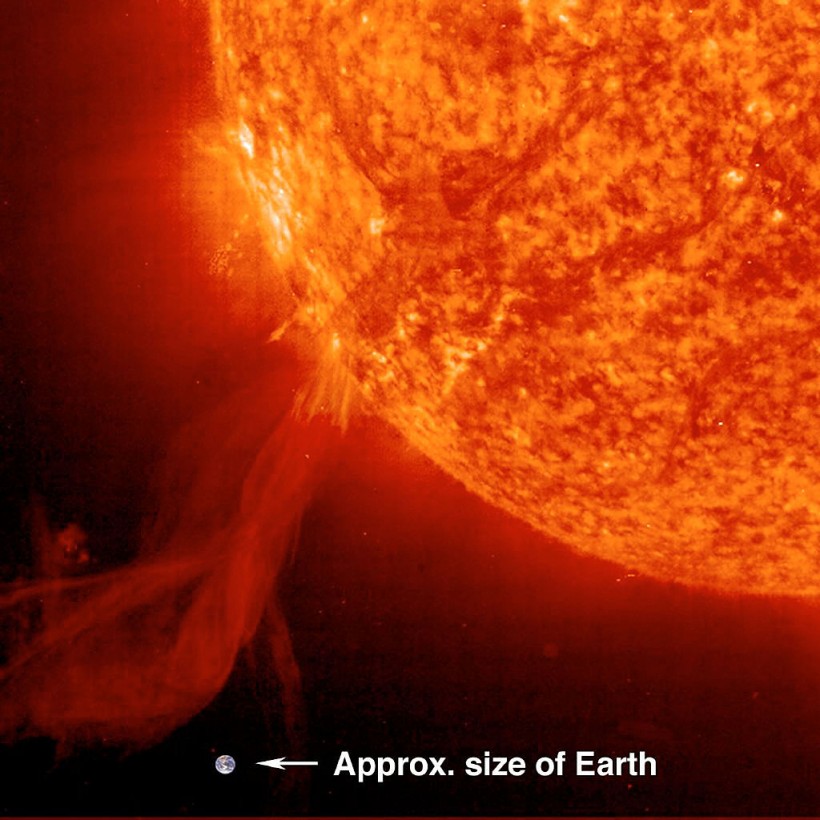A geomagnetic storm is likely to hit Earth on Sunday, May 21.
This is according to reports, which said that a large solar storm involving a powerful explosion from the Sun occurred on Thursday, May 18.
In the next 24 hours, aurora borealis and disruption to radio frequencies and satellite-dependent signals are possible.
Solar Storm Alert

FILE IMAGE - OCTOBER 25: Astronomers at the Solar & Heliospheric Observatory (SOHO) captured this image of a solar prominence erupting from the surface of the Sun on October 25, 2002. Two large prominences were spotted and one is shown here with the Earth in scale to demonstrate the immense size of this solar phenomenon.
A gigantic chunk of solar plasma was emitted by the Sun on Thursday and this could hit our planet by Sunday, affecting Earth's atmosphere and magnetic field, National Oceanic and Atmosphere Administration (NOAA), as cited by Newsweek.
The NOAA said the arrival of the geomagnetic storm, based on model results, could transpire late on Sunday.
This comes as a solar storm occurred near the Region 3309 of the Sun, which is also facing Earth.
Also Read: Solar Flare Alert: Another Solar Storm to Hit the Earth on the 9th of August
What is a Geomagnetic Storm?
Geomagnetic storms are synonymous with solar storms since they are a product of solar flares, coronal mass ejections (CMEs), and other types of solar explosions.
They contain highly-charged particles that travel through space very fast.
When these particles hit Earth, they will pass through our planet's magnetic field first, often resulting in disruption of radio, satellite, and communication signals.
A geomagnetic storm refers to Earth's magnetosphere disturbance.
This happens when such layer is hit by a very powerful "exchange of energy" from solar winds and those of the space environment around the planet, according to the NOAA's Space Weather Prediction Center (SWPC).
Aside from solar storms.
Disruption in the magnetosphere can also occur depending on solar wind conditions, which are effective in producing geomagnetic storms that can last for several hours, the SWPC adds.
The largest geomagnetic storms come from such conditions linked to CMEs which consists of billion tons of plasma from the Sun that can arrive to Earth for several days, the U.S. space weather agency added.
Strongest Geomagnetic Storm
Earth's strongest geomagnetic storm comes from none other than the most powerful solar storm in recorded history, known as the "Carrington Event."
The solar storm was so massive it disrupted even less complex technological equipment at that time.
In 1859, England solar astronomer Richard Carrington was on his usual observation routine during a sunny, cloudless morning on September 1.
He pointed his telescope to the Sun and captured a large group of sunspots, where two beads of white light appeared and intensified after several minutes, the National Aeronautics and Space Administration (NASA) narrated.
Before dawn on September 2, skies worldwide were replaced by red, green, and purple auroras which reached as far as Cuba, El Salvador, Hawaii, and the Bahamas, according to NASA.
The phenomenon was bizarre since most aurora borealis in the Northern Hemisphere only reach the northern tier of the United States and its adjacent areas from the north pole.
Moreover, telegraph stations worldwide at that time malfunctioned.
Reported sparks and discharges shocked telegraph operators on duty and telegraph papers went on fire, the U.S. space agency adds.
While no casualties were reported during the event, a Carrington-level solar storm in today's time will have more impact.
Related Article: Solar Storm: Stream Geomagnetic Storm Travelling at 2.1 Million KM Per Hour Hits Earth
© 2024 NatureWorldNews.com All rights reserved. Do not reproduce without permission.




![Roundworms with Short Memories 'Stop Forgetting' When Frozen or Given Lithium [Study]](https://1471793142.rsc.cdn77.org/data/thumbs/full/70295/280/157/50/40/roundworms-with-short-memories-stop-forgetting-when-frozen-or-given-lithium-study.jpg)
